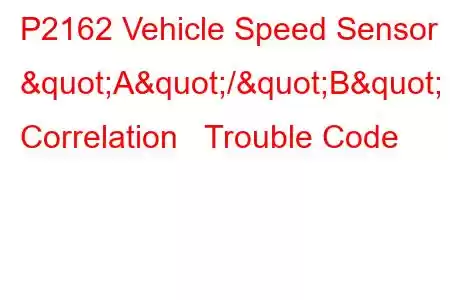P2162 Output Speed Sensor A/B Correlation
OBD-II Trouble Code Technical Description
Output Speed Sensor A/B Correlation
What does that mean?
This is a generic diagnostic trouble code (DTC) and typically applies to OBD-II vehicles. Vehicle makes may include but aren't limited to Ford, Chevy / Chevrolet, etc.
If your OBD-II equipped vehicle has stored a code P2162, it means that the powertrain control module (PCM) has detected a discrepancy between two separate vehicle (output) speed sensors.
The individual vehicle (output) sped sensors have been designated as A and B. The sensor designated as A is normally the forward most sensor in the network but check specifications for the vehicle in question before reaching any diagnostic conclusions.
In the type of system intended to exhibit a code P2162, multiple vehicle (output) speed sensors are used. It is likely that one is located in the differential and the other is situated near the output shaft housing of the transmission (2WD) or transfer case (4WD).
The vehicle (output) speed sensor is an electromagnetic sensor which is mounted in close proximity to some type of toothed reluctor ring wheel or gear. The reluctor ring is mechanically affixed to an axle, transmission/transfer case output shaft, ring gear, or driveshaft. The reluctor ring spins in conjunction with the axle. As the reluctor ring teeth pass within thousandths-of-an-inch of the output shaft speed sensor, the magnetic field completes the sensor input circuit. The notches between the reluctor ring teeth create interruptions in the same circuit. These completions/interruptions occur in rapid succession as the vehicle rolls forward. These circuit completions and interruptions create wave form patterns that are received by the PCM (and other controllers) as vehicle speed or output shaft speed. As wave form pattern speed increases, estimated vehicle and output shaft speed increases. Likewise, as the input speed of the wave form slows, estimated vehicle or output shaft speed decreases.
The PCM is constantly monitoring vehicle (output) speed when the vehicle is moving forward. If the PCM detects a variation between the individual vehicle (output) speed sensors that exceeds the maximum threshold (for a set amount of time) a code P2162 will be stored and a malfunction indicator lamp (MIL) may be illuminated.
A transmission speed sensor:
What is the severity of this DTC?
The conditions which contribute to a code P2162 being stored may cause incorrect speedometer calibration and erratic transmission shifting patterns. The code should be considered severe and addressed as quickly as possible.
What are some of the symptoms of the code?
Symptoms of a P2162 diagnostic code may include:
Erratic speedometer operation Irregular transmission shift patterns Inadvertent ABS or traction control system (TCS) activation ABS codes may be stored The ABS may be disabledWhat are some of the common causes of the code?
Causes for this P2162 code may include:
Incorrect final drive gear ratio (differential ring gear and pinion) Transmission slippage Excessive metallic debris on vehicle (output)/output shaft speed sensor magnet Defective vehicle (output)/output shaft speed sensor Cut or damaged wiring or connectors Broken, damaged, or worn reluctor ring teeth Faulty PCM or PCM programming errorWhat are some P2162 diagnostic and troubleshooting steps?
A diagnostic scanner with a built-in oscilloscope, a digital volt/ohmmeter (DVOM), and a source of reliable vehicle information will be needed to diagnose a code P2162.
With a stored P2162, I would make sure that my automatic transmission was full of clean fluid that did not smell burnt. If the transmission was leaking, I would repair the leak and fill it with fluid, then drive it to make sure that it had not undergone mechani
Read: 26


